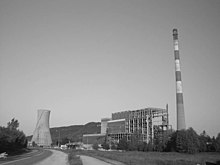Ugljevik Power Plant
| Ugljevik Power Plant | |
|---|---|

Ugljevik Power Plant
|
|
| Official name | Термоелектрана "Угљевик" |
| Country | Bosnia and Herzegovina |
| Location | Ugljevik, Republic of Srpska |
| Coordinates | 44°40′55″N 18°58′2″E / 44.68194°N 18.96722°ECoordinates: 44°40′55″N 18°58′2″E / 44.68194°N 18.96722°E |
| Status | Operational |
| Construction began | 1976 |
| Commission date | 1985 |
| Owner(s) | Elektroprivreda Republike Srpske |
| Operator(s) | Rudnik i termoelektrana Ugljevik |
| Thermal power station | |
| Primary fuel | Coal |
| Cogeneration? | yes |
| Power generation | |
| Units operational | 1 X 300 MW |
| Make and model |
LMZ Electrosila Končar |
| Nameplate capacity | 300 MW |
The Ugljevik Power Plant (Serbian: Термоелектрана "Угљевик") is a coal-fired power plant in Ugljevik, Republic of Srpska, Bosnia and Herzegovina. It is owned and operated by Rudnik i termoelektrana Ugljevik, a subsidiary of Elektroprivreda Republike Srpske. RiTE Ugljevik is an integrated coal-mining and power generating company.
Ugljevik has been coal mining area since 1899. Construction of the coal-fired power plant started in 1976 and the first and only unit was commissioned in 1985. At the same time, the old Ugljevik coal mine was closed, the new Bogutovo Selo mine was opened, and the integrated coal-mining and power generating company RiTE Ugljevik was created on the base of Rudnik Ugljevik mining company.
Construction of the second unit started in 1985 and halted during the Bosnian War. During the war, the power plant was closed from April 1992 to November 1995, though the facilities and equipment were saved in expectation of resuming production.
In 2010, the power plant went through extensive upgrading.
The Ugljevik Power Plant is now one of the largest generators of electricity in Republika Srpska. It has a combined heat and power generation unit with an installed capacity of 300 MW. In 2009, it generated 1,559 GWh of electricity and consumed 1.3 million tonnes of coal.
The power plant has a 310-metre (1,020 ft) tall flue gas stack, the tallest structure in Bosnia and Herzegovina. Before the Bosnian War on the top of chimney with big white letters was written 'TITO', in memory of communist leader of former Yugoslavia Josip Broz Tito. During the war text was rewritten, so now is visible a Serbian symbol, the Serbian cross.
...
Wikipedia

